Mathematical Modelling of Fault Reactivation Induced by Water Injection
Abstract
1. Introduction
2. Geological and Experimental Setting
3. Mathematical Modelling of Injection Test in Secondary Fault
3.1. Governing Equations
3.2. Hydro-Mechanical Characteristics of Rock Mass and Fault
3.3. Base Case Results for Simulation of Secondary Fault Injection Test
4. Parametric Study
4.1. Effects of Fault Shear Strength Parameters
- (1)
- a damage enhancement factor of 20 instead of 28
- (2)
- a dilation angle of 10° as compared to 17°
- (3)
- a friction angle of 20° instead of 22°
4.2. Effects of Fault Heterogeneity
4.3. Effects of In-Situ Stress
5. Conclusions
Author Contributions
Funding
Acknowledgments
Conflicts of Interest
References
- McGarr, A.; Bekins, B.; Burkhardt, N.; Dewey, J.; Earle, P.; Ellsworth, W.; Ge, S.; Hickman, S.; Holland, A.; Majer, E.; et al. Coping with earthquakes induced by fluid injection. Science 2015, 347, 830–831. [Google Scholar] [CrossRef]
- Zhao, H.; Ma, F.; Liu, G.; Feng, X.; Guo, J. Analytical investigation of hydraulic fracture-induced seismicity and fault activation. Environ. Earth Sci. 2018, 77, 526. [Google Scholar] [CrossRef]
- Noronha, J. Deep Geological Repository Design Report—Crystalline/Sedimentary Rock environment; Report APM-REP-00440-0015 R001; Nuclear Waste Management Organization: Toronto, ON, Canada, 2016; Available online: https://www.nwmo.ca/en/Reports (accessed on 6 May 2019).
- Posiva, O. Safety Case for the Disposal of Spent Nuclear Fuel at Olkiluoto—Synthesis 2012. Posiva Oy 2012. Report POSIVA 2012-12. Available online: http://www.posiva.fi/en/final_disposal/safety/the_safety_case#.W_cCPrCoszs (accessed on 6 May 2019).
- ANDRA. Dossier options de Surete−Partie apres Fermeture. ANDRA 2016. Identification CG-TE-D-NTE-AMOA-SR2-0000-15-0062/A. Available online: https://www.andra.fr/cigeo/les-documents-de-reference (accessed on 6 May 2019).
- Kanamori, H. Energy budget of earthquakes and seismic efficiency. Int. Geophys. 2001, 76, 293–305. [Google Scholar] [CrossRef]
- Behnsen, J.; Faulkner, D. The effect of mineralogy and effective normal stress on frictional strength of sheet silicates. J. Struct. Geol. 2012, 4, 49–61. [Google Scholar] [CrossRef]
- Orellana, L.F.; Scuderi, M.M.; Collettini, C.; Violay, M. Do scaly clays control seismicity on faulted shale rocks? Earth Planet. Sci. Lett. 2018, 488, 59–67. [Google Scholar] [CrossRef]
- Orellana, L.F.; Scuderi, M.M.; Collettini, C.; Violay, M. Frictional Properties of Opalinus Clay: Implications for Nuclear Waste Storage. J. Geophys. Res. Solid Earth 2018, 123, 157–175. [Google Scholar] [CrossRef]
- Rutter, E.H.; Mecklenburgh, J. Influence of Normal and Shear Stress on the Hydraulic Transmissivity of Thin Cracks in a Tight Quartz Sandstone, a Granite, and a Shale. J. Geophys. Res. Solid Earth 2018, 123, 1262–1285. [Google Scholar] [CrossRef]
- Scuderi, M.M.; Collettini, C. Fluid Injection and the Mechanics of Frictional Stability of Shale-Bearing Faults. J. Geophys. Res. Solid Earth 2018, 123, 8364–8384. [Google Scholar] [CrossRef]
- Orellana, L.F.; Giorgetti, C.; Violay, M. Contrasting mechanical and hydraulic properties of wet and dry fault zones in a proposed shale-hosted nuclear waste repository. Geophys. Res. Lett. 2019, 46, 1357–1366. [Google Scholar] [CrossRef]
- Rutqvist, J.; Rinaldi, A.P.; Cappa, F.; Jeanne, P.; Mazzoldi, A.; Urpi, L.; GuGlielmi, Y.; Villarrasa, V. Fault activation and induced seismicity in geological carbon storage—Lesson learned from recent modeling studies. J. Rock Mech. Geotech. Eng. 2016, 8, 789–804. [Google Scholar] [CrossRef]
- Eaton, D.W.; Schultz, R. Increased likelihood of induced seismicity in highly overpressured shale formations. Geophys. J. Int. 2018, 214, 751–757. [Google Scholar] [CrossRef]
- Ellsworth, W. Injection-induced earthquakes. Science 2013, 341, 142–149. [Google Scholar] [CrossRef] [PubMed]
- Guglielmi, Y.; Cappa, F.; Avouac, J.P.; Henry, P.; Elsworth, D. Seismicity triggered by fluid injection-induced aseismic slip. Science 2015, 348, 1224–1226. [Google Scholar] [CrossRef] [PubMed]
- Guglielmi, Y.; Elsworth, D.; Cappa, F.; Henry, P.; Gout, C.; Dick, P.; Durand, J. In situ observations on the coupling between hydraulic diffusivity and displacements during fault reactivation in shales. J. Geophys. Res. 2015, 120, 7729–7748. [Google Scholar] [CrossRef]
- Guglielmi, Y.; Henry, P.; Nussbaum, C.; Dick, P.; Gout, C.; Amann, F. Underground Research Laboratories for Conducting Fault Activation Experiments in Shales. In Proceedings of the 49th U.S. Rock Mechanics/Geomechanics Symposium, San Francisco, CA, USA, 28 June–1 July 2015. [Google Scholar]
- Guglielmi, Y.; Birkholtzer, J.; Rutqvist, J.; Jeanne, P.; Nussbaum, C. Can fault leakage occur before or without reactivation? Results from an in-situ reactivation at Mont Terri. Energy Procedia 2017, 114, 3167–3174. [Google Scholar] [CrossRef]
- Thury, M.; Bossart, P. The Mont Terri rock laboratory, a new international research project in a Mesozoic shale formation, in Switzerland. Eng. Geol. 1999, 52, 347–359. [Google Scholar] [CrossRef]
- Bossart, P.; Bernier, F.; Birkholzer, J.; Bruggeman, C.; Connolly, P.; Dewonck, S.; Fukaya, M.; Herfort, M.; Jensen, M.; Matray, J.-M.; et al. Mont Terri rock laboratory, 20 years of research: Introduction, site characteristics and overview of experiments. Swiss J. Geosci. 2017, 110, 3–22. [Google Scholar] [CrossRef]
- Jaegg, D.; Laurich, B.; Nussbaum, C.; Sschuster, K.; Connolly, P. Tectonic structure of the “Main Fault” in the Opalinus Clay, Mont Terri rock laboratory (Switzerland). Swiss J. Geosci. 2017. [Google Scholar] [CrossRef]
- Laurich, B.; Urai, J.L.; Desbois, G.; Vollmer, C.; Nussbaum, C. Microstructural evolution of an incipient fault zone in Opalinus Clay: Insights from an optical and electron microscopic study of ion-beam polished samples from the Main Fault in the Mt-Terri Underground Research Laboratory. J. Struct. Geol. 2014, 67, 107–128. [Google Scholar] [CrossRef]
- Laurich, B.; Urai, J.L.; Nussbaum, C. Microstructures and deformation mechanisms in Opalinus Clay: Insights from scaly clay from the Main Fault in the Mont Terri Rock Laboratory (CH). Solid Earth 2017, 8, 27–44. [Google Scholar] [CrossRef]
- Nussbaum, C.; Kloppenburg, A.; Caër, T.; Bossart, P. Tectonic evolution around the Mont Terri rock laboratory, northwestern Swiss Jura: Constraints from kinematic forward modelling. Swiss J. Geosci. 2017, 110, 39–66. [Google Scholar] [CrossRef]
- Nussbaum, C.; Bossart, P.; Amann, F.; Aubourg, C. Analysis of tectonic structures and excavation induced fractures in the Opalinus Clay, Mont Terri underground rock laboratory (Switzerland). Swiss J. Geosci. 2011, 104, 187–210. [Google Scholar] [CrossRef]
- Guglielmi, Y.; Cappa, F.; Lançon, H.; Janowczyk, J.B.; Rutqvist, J.; Tsang, C.F.; Wang, J.S.Y. ISRM Suggested Method for Step-Rate Injection Method for Fracture In-Situ Properties (SIMFIP): Using a 3-Components Borehole Deformation Sensor. Rock Mech. Rock Eng. 2013, 47, 303–311. [Google Scholar] [CrossRef]
- Zimmerman, R.W.; Bodvarsson, G.S. Hydraulic Conductivity of Rock Fractures; Report LBL-35976; Earth Sciences Division, Lawrence Berkeley Laboratory: Berkeley, CA, USA, 1994.
- Gens, A.; Vaunat, J.; Garitte, B.; Wileveau, Y. In-situ behaviour of a stiff layered clay subject to thermal loading: Observations and interpretation. Geotechnique 2007, 57, 207–228. [Google Scholar] [CrossRef]
- Corkum, A.; Martin, D. The mechanical behavior of weak mudstone (Opalinus Clay) at low stresses. Int. J. Rock Mech. Min. Sci. 2007, 44, 196–209. [Google Scholar] [CrossRef]
- Martin, C.D.; Lanyon, G.W. Measurement of in-situ stress in weak rocks at Mont Terri Rock Laboratory, Switzerland. Int. J. Rock Mech. Min. Sci. 2003, 40, 1077–1088. [Google Scholar] [CrossRef]
- Sjodin, B. How to Generate Random Surfaces in COMSOL Multiphysics®, COMSOL blog. Available online: https://www.comsol.com/blogs/how-to-generate-random-surfaces-in-comsol-multiphysics/ (accessed on 6 May 2019).
- Peitgen, H.O.; Saupe, D. The Science of Fractal Images; Springer-Verlag: New York, NY, USA, 1988. [Google Scholar]

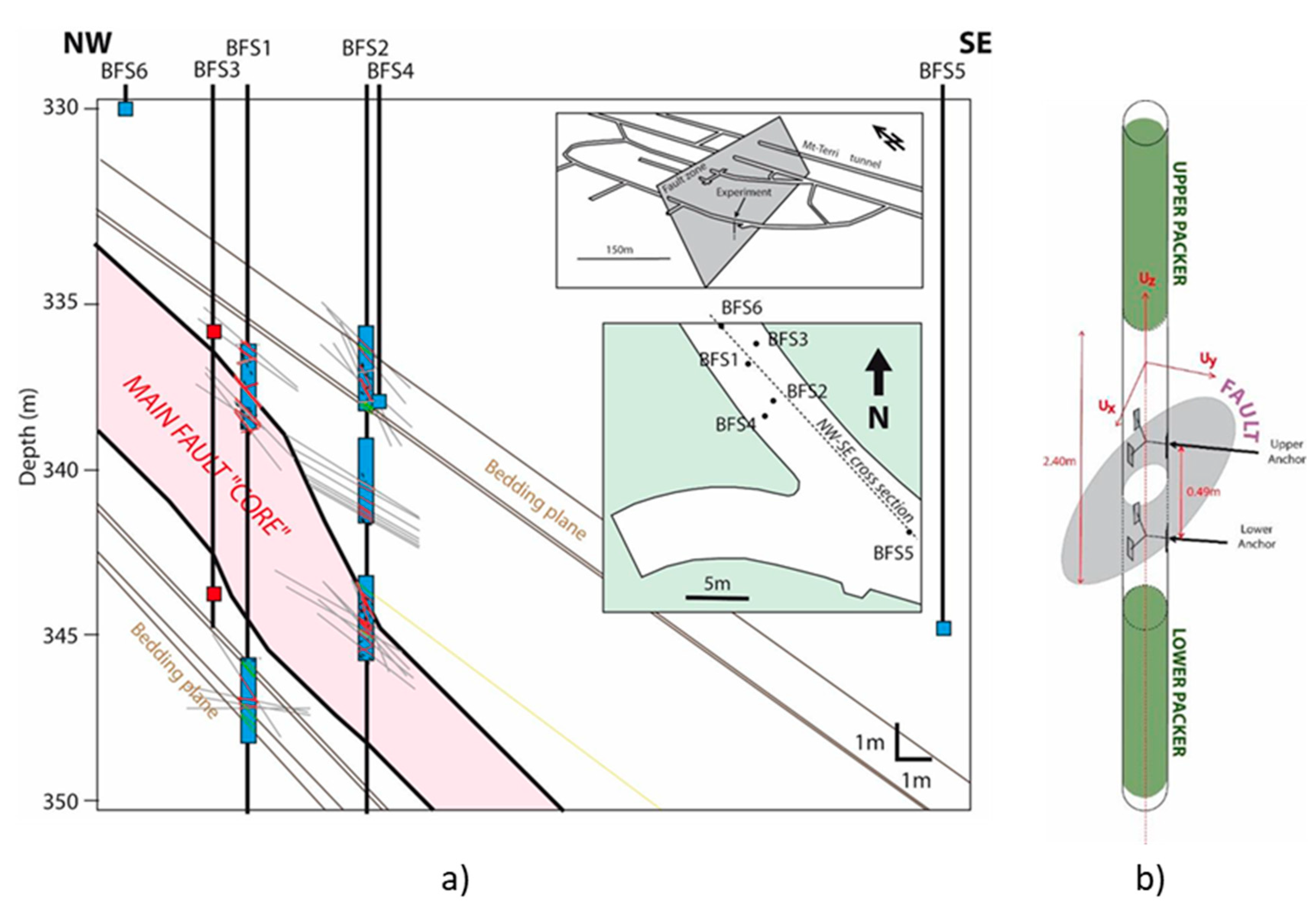
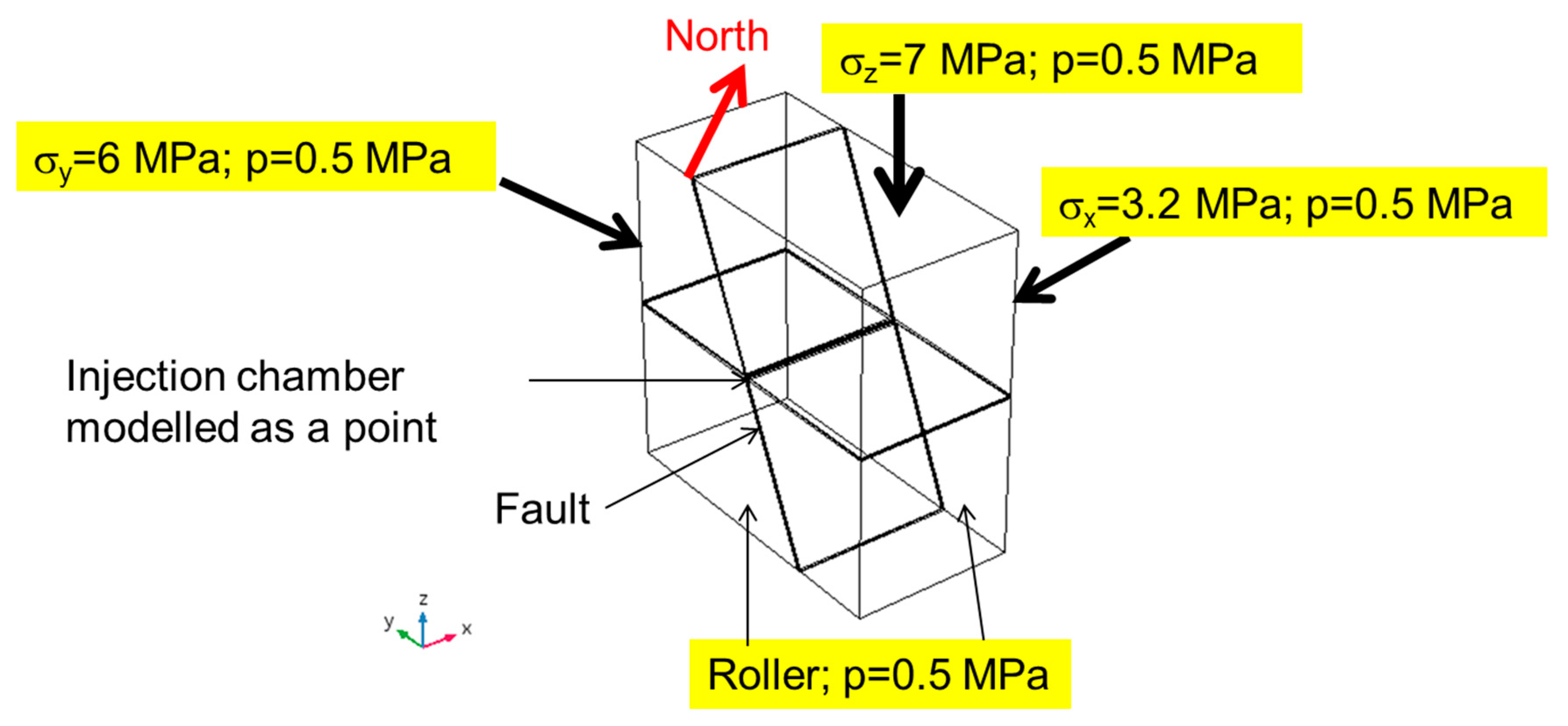
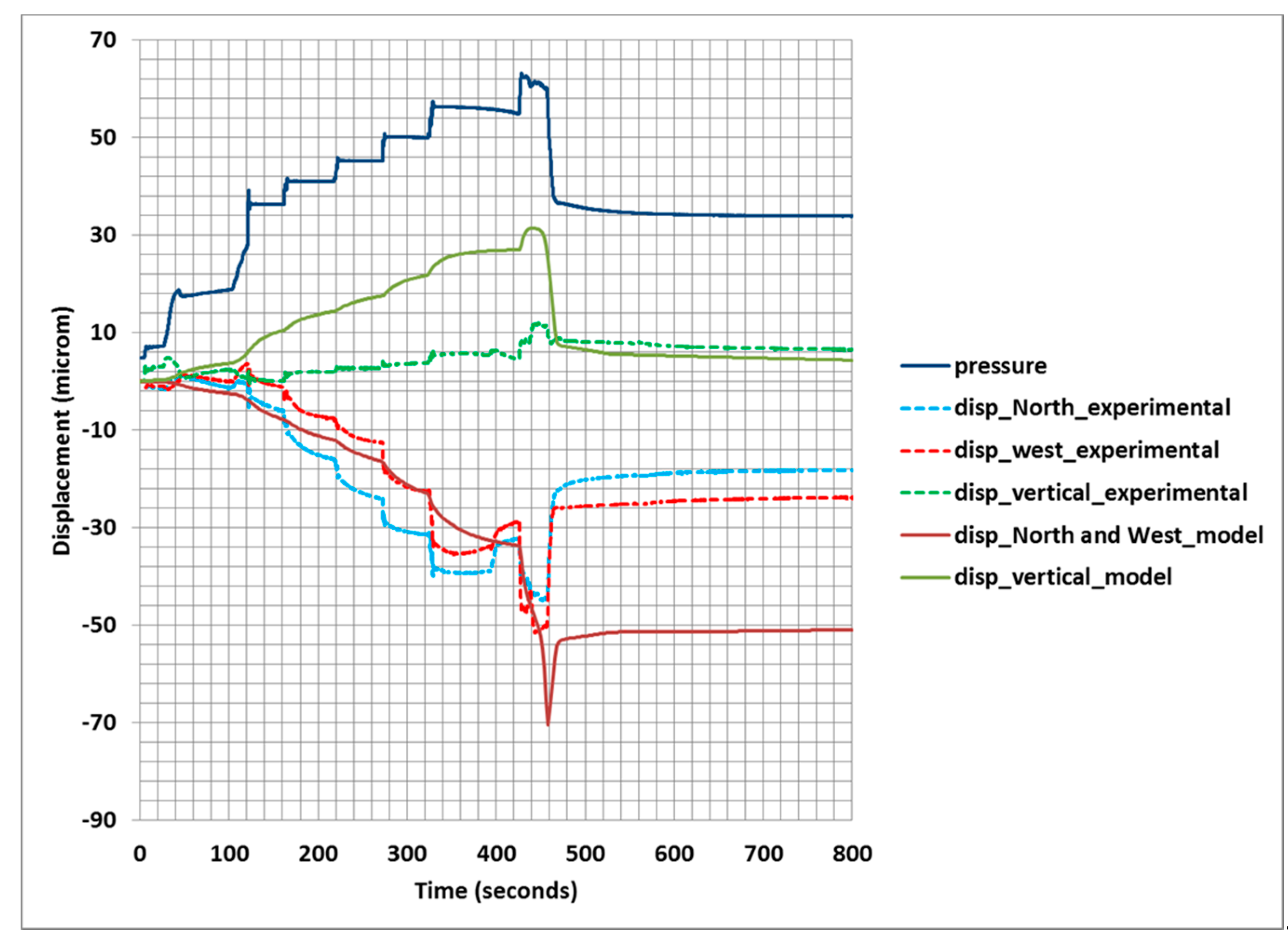
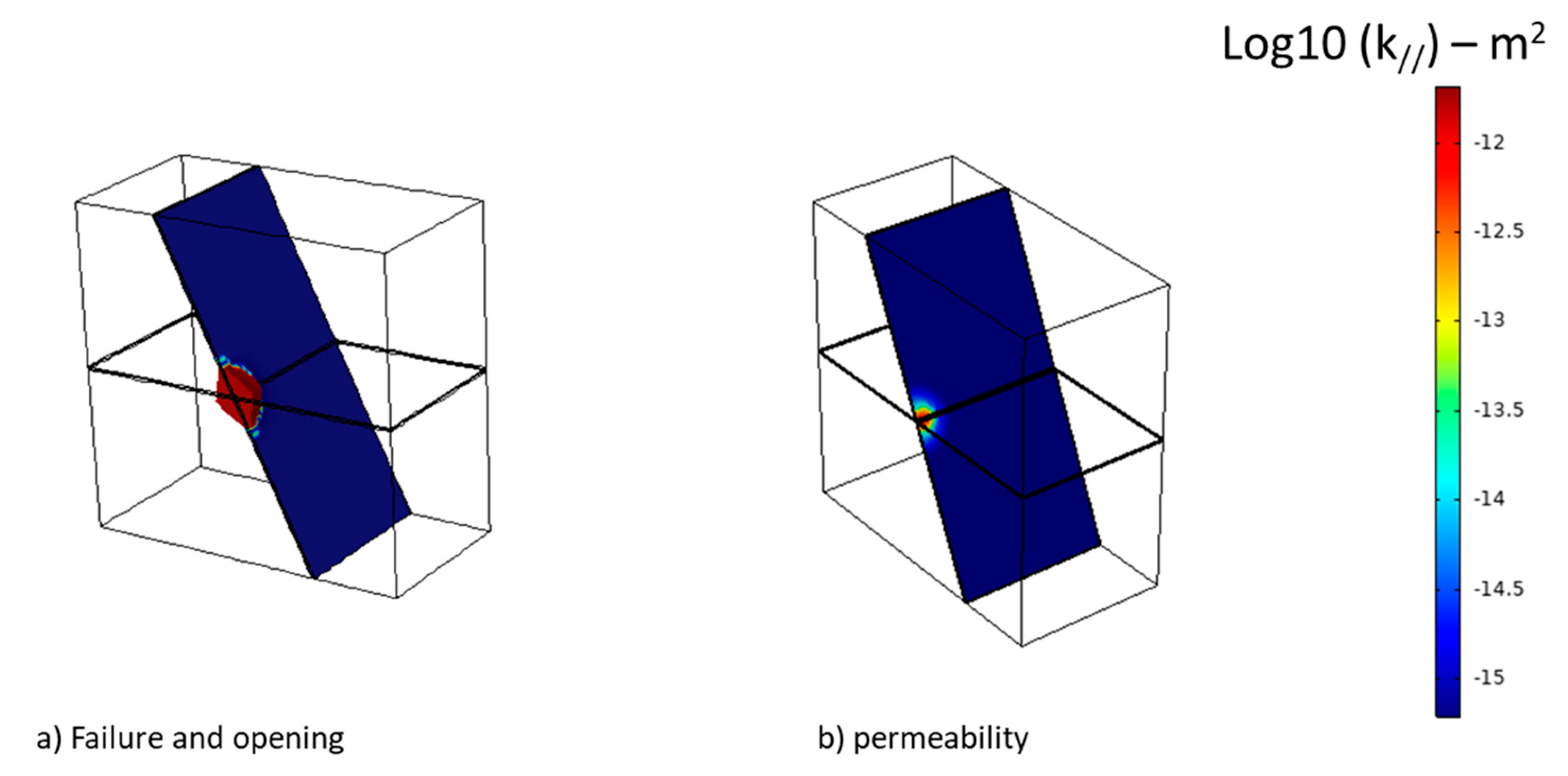

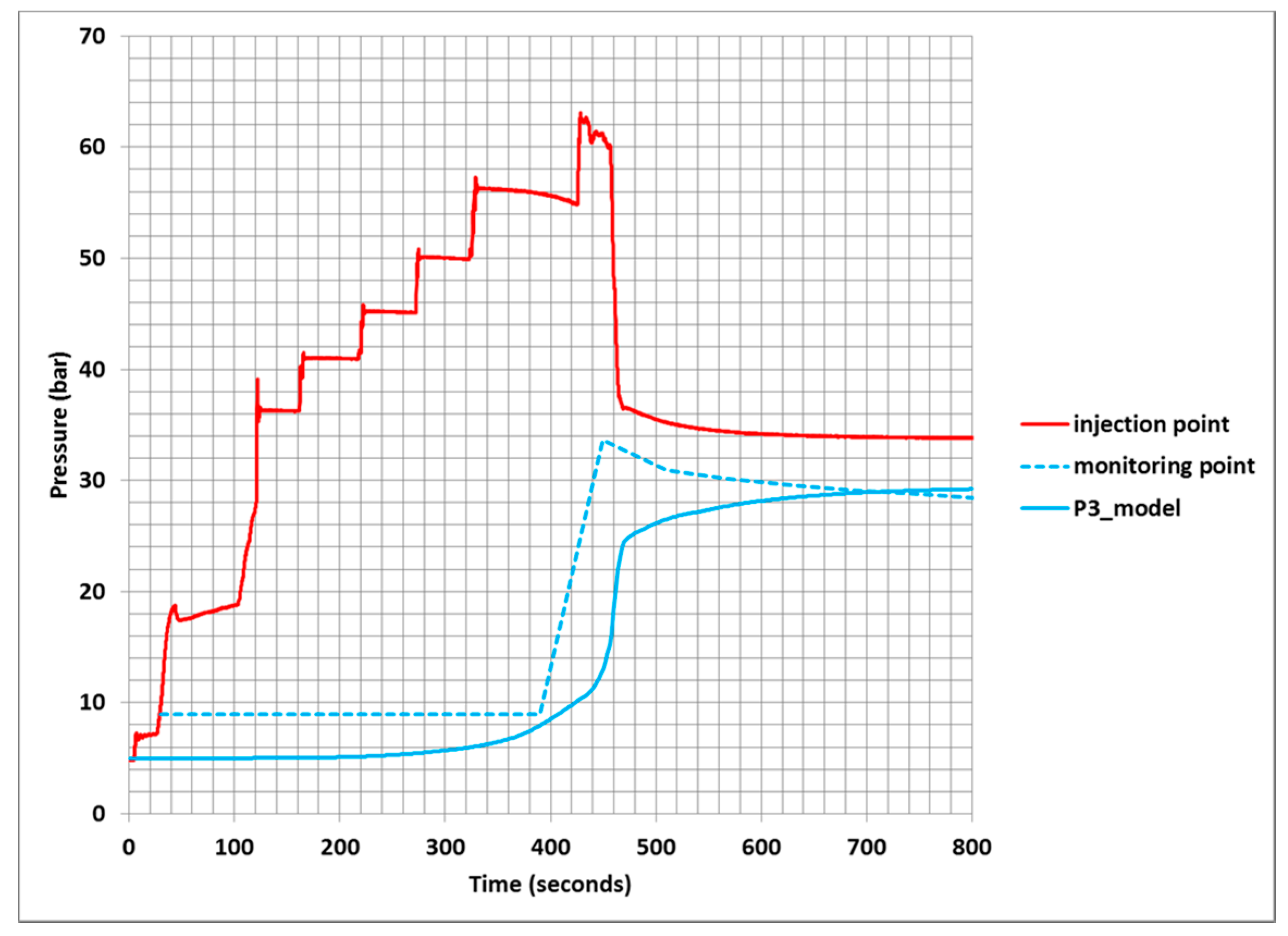
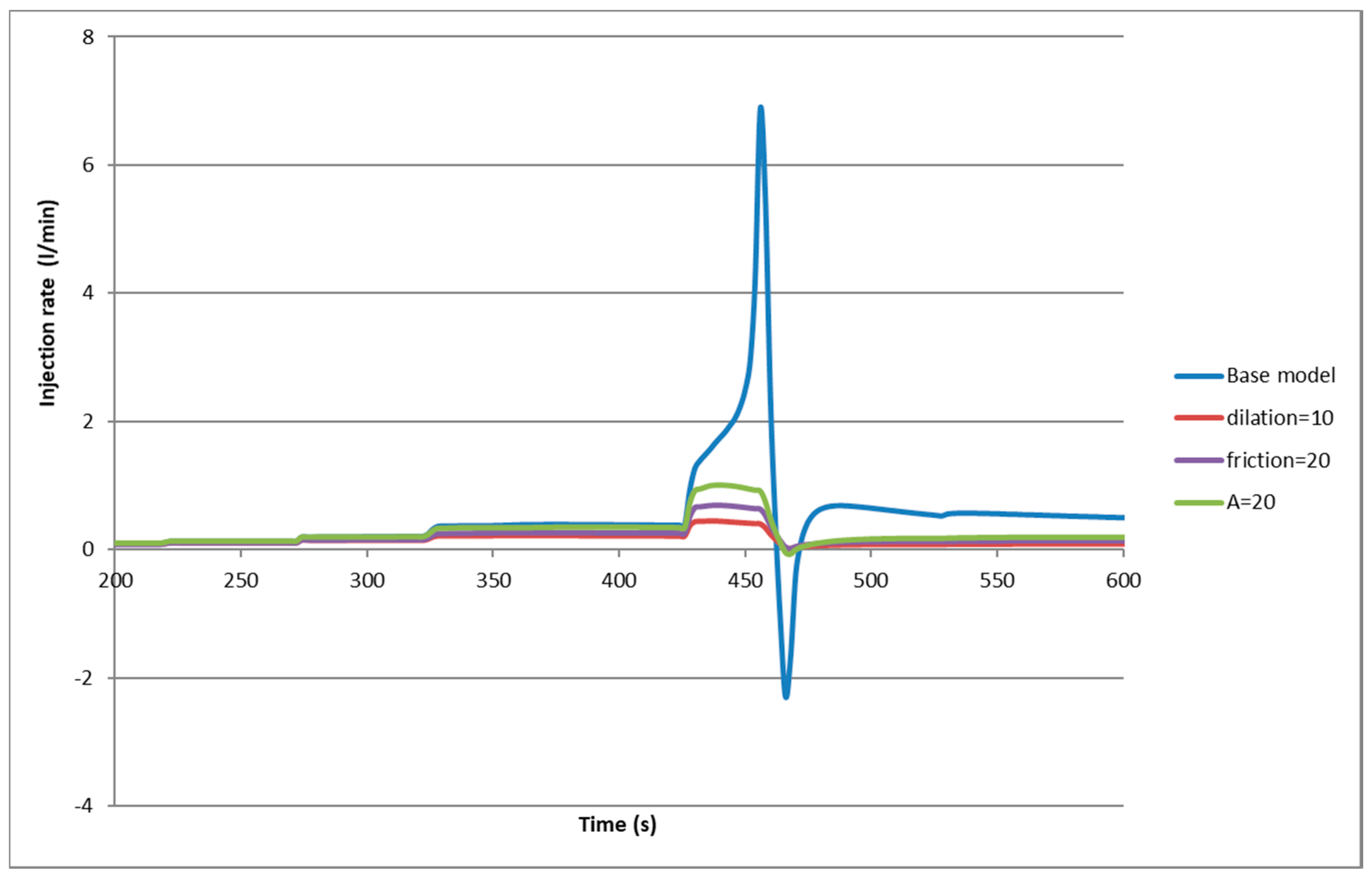
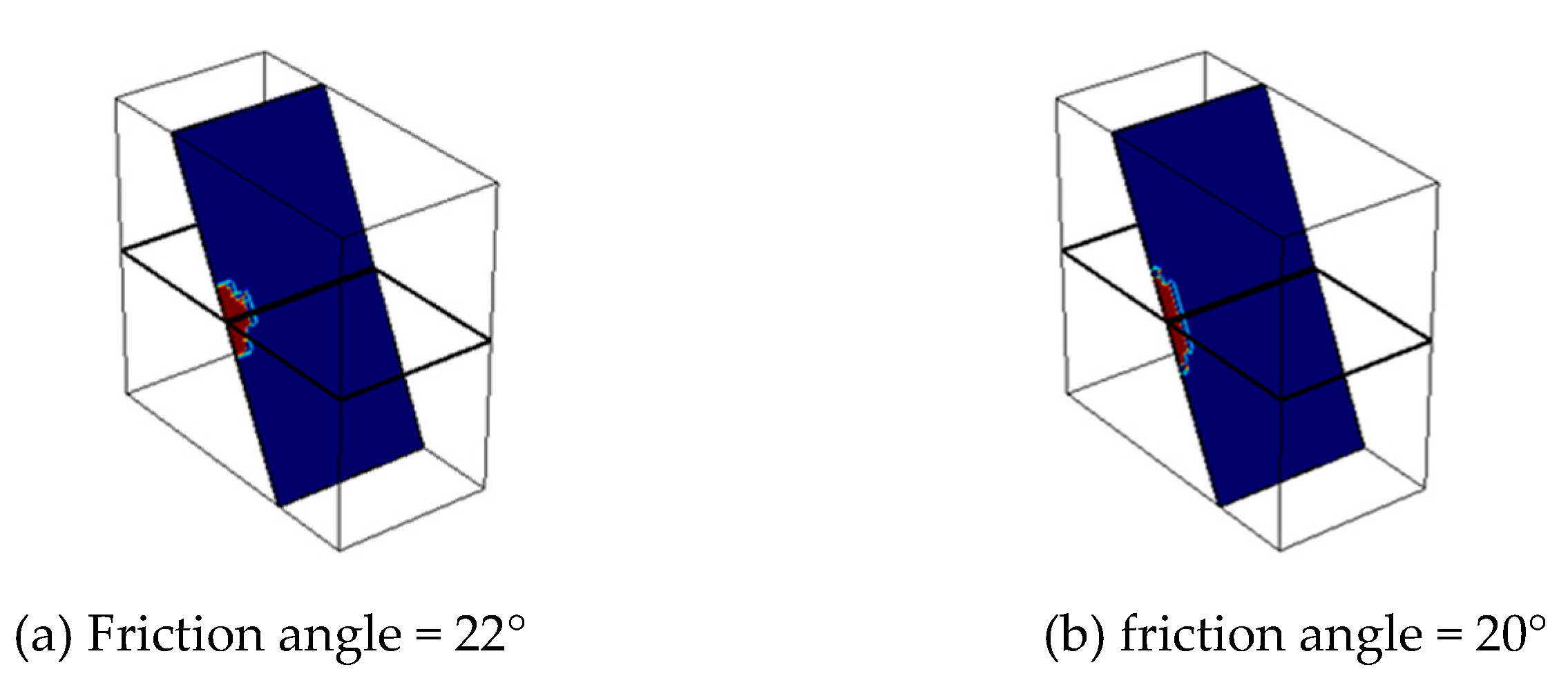
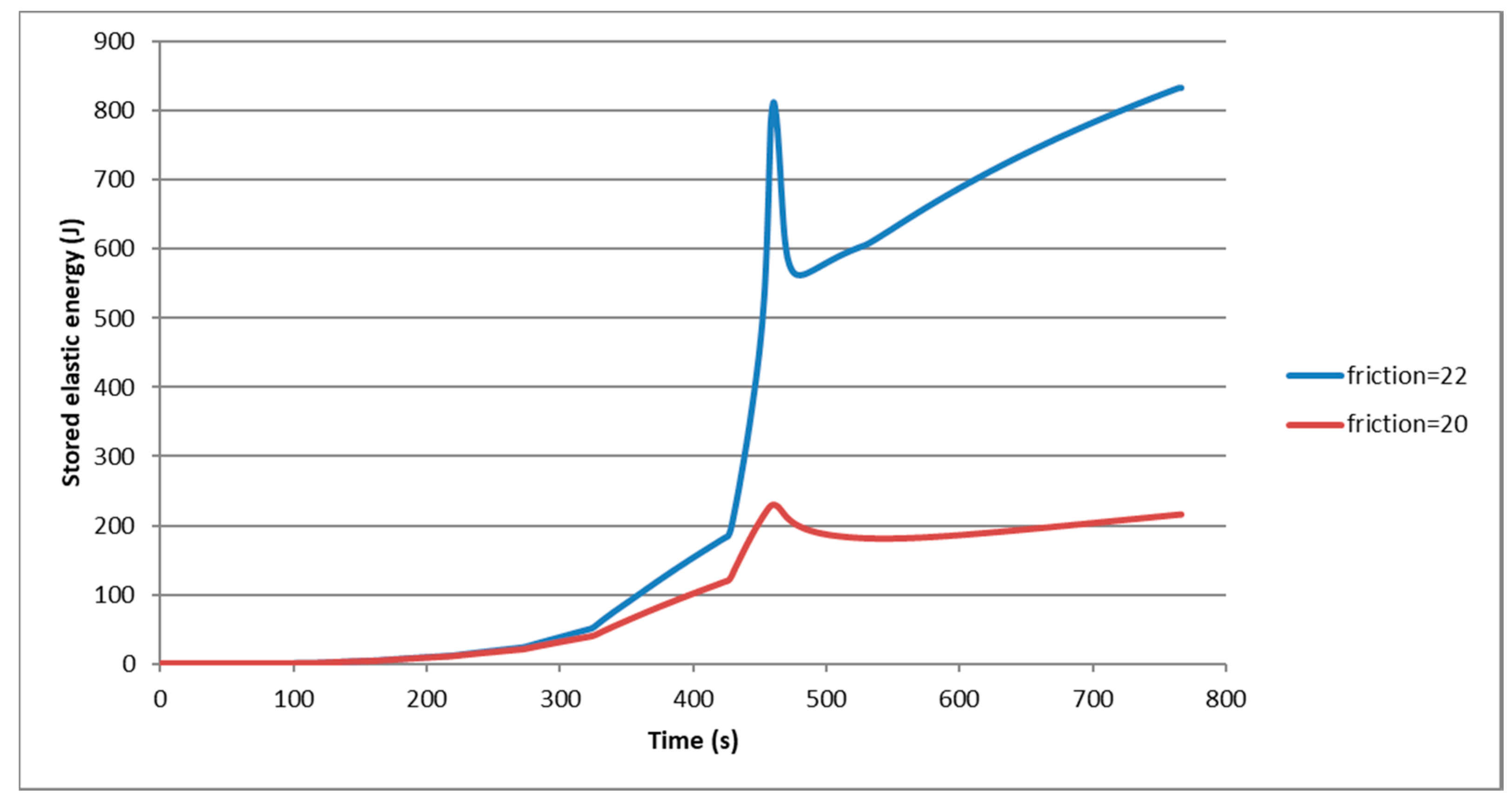

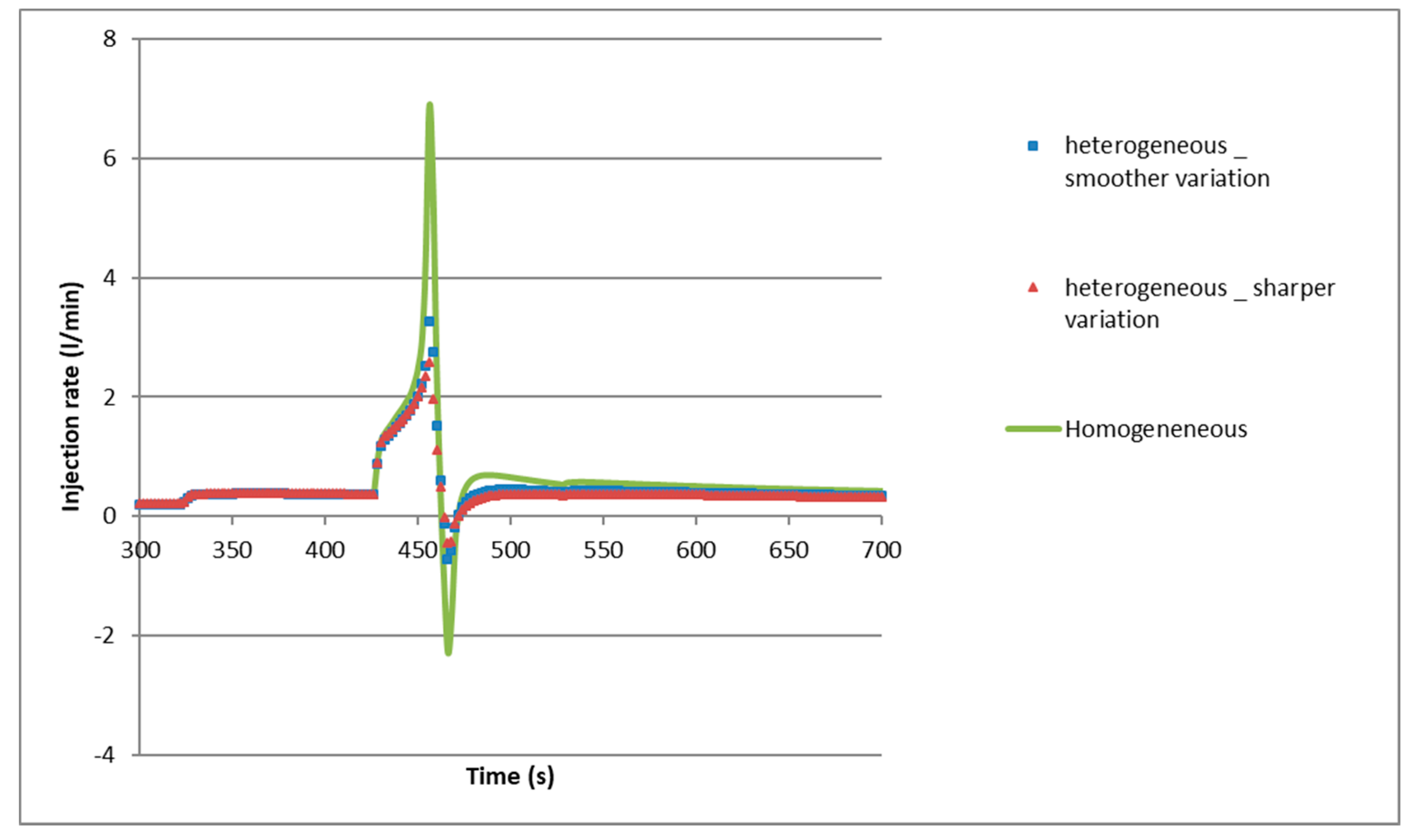
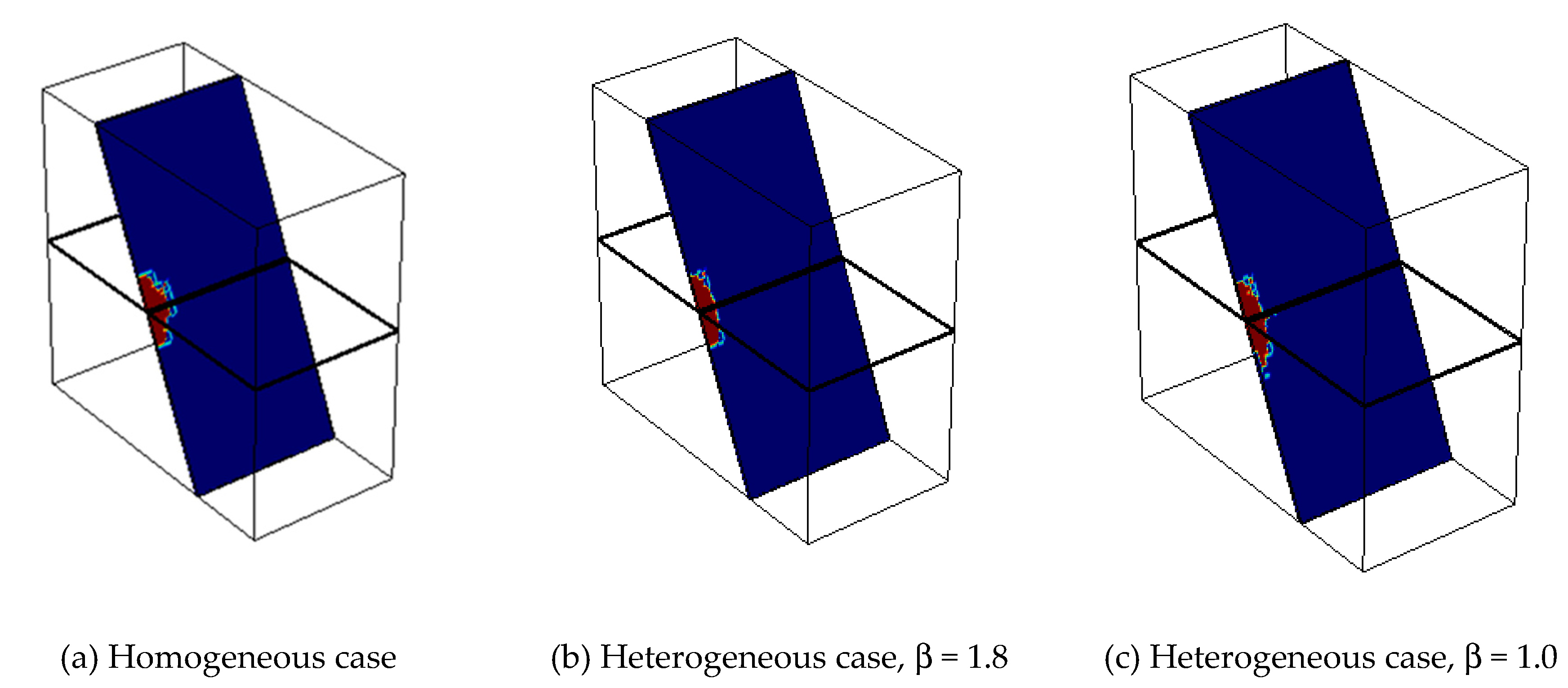
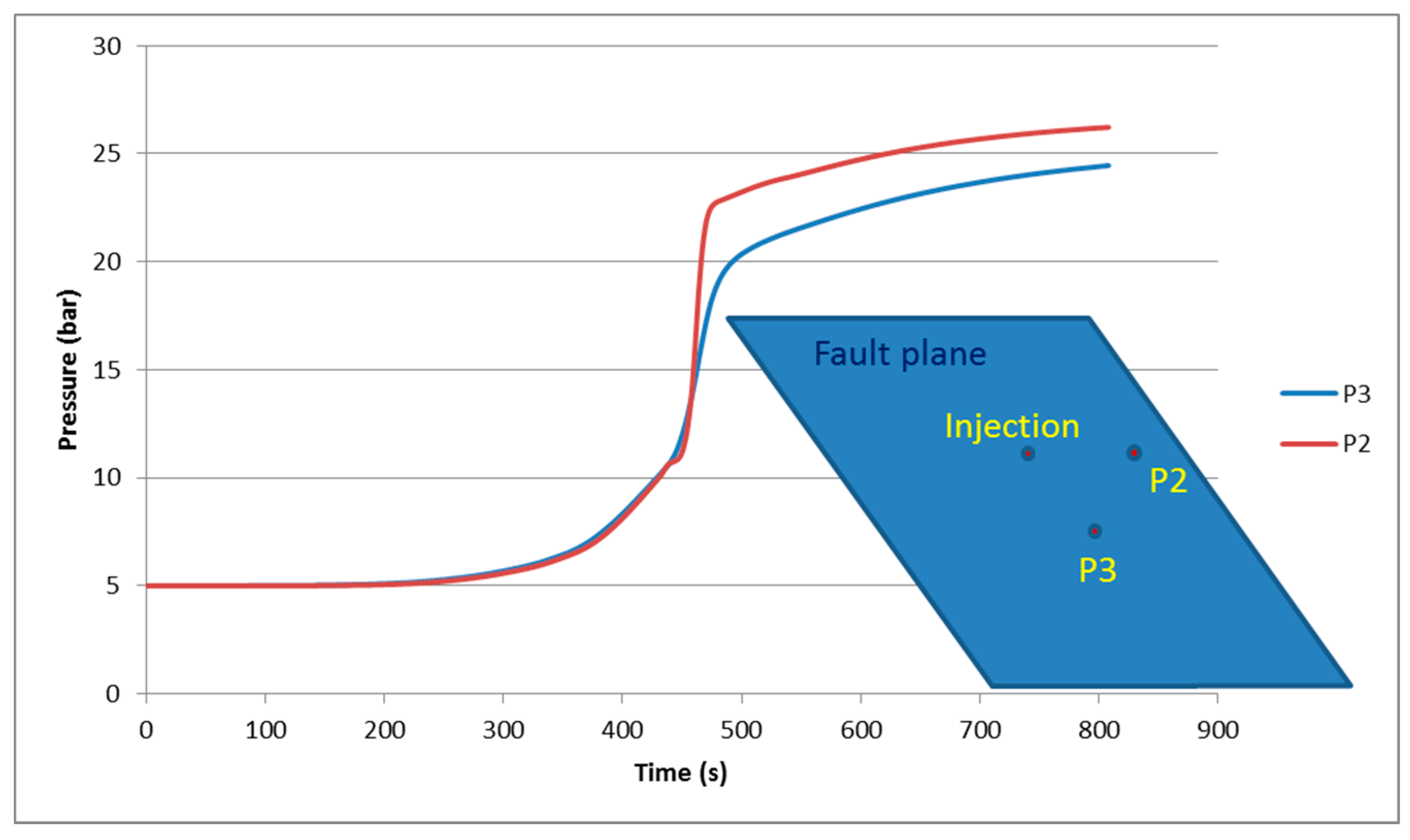

| Property | Rock Mass | Fault |
|---|---|---|
| Young’s modulus | 6.3 GPa | 12 GPa perpendicular to fault 60 GPa parallel to fault plane |
| Poisson ratio | 0.32 | |
| Shear modulus | 4 GPa (for shear movement between fault walls) 30 GPa (for shear in fault plane) | |
| Permeability | 10−20 m2 | 10−20 m2 for flow perpendicular to fault Equations (3) and (4) for flow parallel to fault plane |
| Friction angle | 22° | |
| Cohesion | 0 | |
| Dilation angle | 17° | |
| Initial fracture hydraulic aperture | 5 mm | |
| Fracture spacing | 1.66 cm | |
| Fault thickness | 20 cm | |
| Damage enhancement Factor A | 28 [-] |
© 2019 by the authors. Licensee MDPI, Basel, Switzerland. This article is an open access article distributed under the terms and conditions of the Creative Commons Attribution (CC BY) license (http://creativecommons.org/licenses/by/4.0/).
Share and Cite
Nguyen, T.S.; Guglielmi, Y.; Graupner, B.; Rutqvist, J. Mathematical Modelling of Fault Reactivation Induced by Water Injection. Minerals 2019, 9, 282. https://doi.org/10.3390/min9050282
Nguyen TS, Guglielmi Y, Graupner B, Rutqvist J. Mathematical Modelling of Fault Reactivation Induced by Water Injection. Minerals. 2019; 9(5):282. https://doi.org/10.3390/min9050282
Chicago/Turabian StyleNguyen, Thanh Son, Yves Guglielmi, Bastian Graupner, and Jonny Rutqvist. 2019. "Mathematical Modelling of Fault Reactivation Induced by Water Injection" Minerals 9, no. 5: 282. https://doi.org/10.3390/min9050282
APA StyleNguyen, T. S., Guglielmi, Y., Graupner, B., & Rutqvist, J. (2019). Mathematical Modelling of Fault Reactivation Induced by Water Injection. Minerals, 9(5), 282. https://doi.org/10.3390/min9050282






